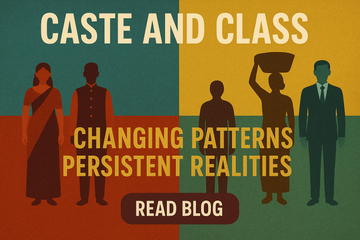India’s social fabric is intricately woven with the threads of caste and class. While the caste system is one of the oldest forms of social stratification in the world, the emergence of class divisions, especially in post-independence India, has added new layers of complexity. Understanding the interaction between caste and class in contemporary India is crucial – not just for scholars and sociologists, but also for UPSC aspirants seeking to grasp the complex dynamics of Indian society.
This blog delves deeper into the sociological intricacies of caste and class in modern India, providing insights into their historical roots, evolving nature, intersectionality, and relevance in today’s social, political, and economic contexts. For aspirants preparing for competitive examinations, especially the UPSC Civil Services Mains (Sociology Optional), this theme forms a vital part of Paper 2.
Understanding the Concepts: Caste and Class
Caste: The Traditional Hierarchy
Caste in India is an age-old, rigid system of hierarchical social organization that divides people into groups based on birth. Traditionally linked to varna (Brahmins, Kshatriyas, Vaishyas, Shudras) and jati (thousands of sub-castes), caste influences one’s occupation, social behavior, and life opportunities.
Key Features:
- Ascriptive in nature (based on birth)
- Endogamy (marriage within caste)
- Social segregation (e.g., food, residence)
- Occupational specialization
Even though untouchability was constitutionally abolished and various laws have been enacted to promote equality, caste discrimination still subtly persists in rural and urban spaces.
Class: The Economic Dimension
Class, unlike caste, is an achieved status often based on economic capital, education, lifestyle, and social mobility. Post-liberalization India witnessed a growing middle class, the rise of the corporate sector, and economic diversification, which added new class formations.
Key Features:
- Fluid and dynamic
- Based on income, education, and assets
- Allows upward and downward mobility
- More dominant in urban India
Caste and Class: Are They Interlinked in India?
Though caste and class are theoretically distinct concepts, in the Indian context, they intersect and overlap. Sociologists like M.N. Srinivas and Andre Béteille have explored how caste has adapted itself to modernity, thereby acquiring class characteristics.
M.N. Srinivas' 'Sanskritization' and 'Dominant Caste'
He explained how lower castes attempt to elevate their status by imitating upper-caste behavior (Sanskritization), and how certain castes assert political and economic dominance (dominant caste) irrespective of traditional hierarchy.
Andre Béteille's Caste-Class Continuum
Béteille argued that caste and class should not be seen as entirely separate but rather on a continuum. For example, a Dalit entrepreneur may belong to a lower caste but hold an upper-class economic status.
Caste-Class Dynamics in Contemporary India
1. Economic Liberalization and New Class Structures
Post-1991 reforms led to rapid urbanization, the rise of IT and service sectors, and the emergence of a new middle class. However, the benefits were not equitably distributed, often reinforcing caste-based inequalities.
- Upper castes dominate white-collar jobs and elite institutions.
- Marginalized castes remain underrepresented despite reservations.
2. Reservation Policies and Social Mobility
Affirmative action has enabled access to education and employment for Scheduled Castes (SCs), Scheduled Tribes (STs), and Other Backward Classes (OBCs), but:
- There is a "creamy layer" debate within OBCs.
- Social mobility does not always result in the acceptance or eradication of caste discrimination.
3. Caste in Urban Spaces
Urbanization was once believed to "dilute" caste, but studies reveal otherwise:
- Urban housing is often caste-segregated.
- Caste-based matrimonial ads, associations, and cultural practices persist.
- Discrimination in employment (e.g., Dalit candidates being filtered out) continues subtly.
4. Political Assertion and Caste-Based Mobilization
Caste has become a tool of political identity:
- Parties like BSP (Bahujan Samaj Party) have risen on the back of Dalit assertion.
- Caste census and demand for reservations by dominant castes (Patels, Marathas, Jats) show how caste intersects with economic anxieties.
5. Digital India and the Caste Divide
Access to the internet and digital resources reflects a class divide, but it also amplifies caste issues:
- Dalit voices have gained platforms through social media.
- However, online harassment and discrimination are rampant.
The Sociological Significance for UPSC Aspirants
For UPSC aspirants opting for Sociology, understanding caste and class is not just academic but strategic. This topic forms a core section in Paper II of the optional subject, where aspirants must analyze the structure and change in Indian society.
This is where the “UPSC 2026: Sociology (Optional) How to Tackle Guide” by Remya Roshni becomes an essential resource.
How This Book Helps:
- Comprehensive Coverage of Paper I & II: The book includes foundational sociological theories and in-depth discussions on Indian society, including caste, class, kinship, religion, and social change.
- Exam-Oriented Content: Designed specifically for UPSC and state-level civil services, the book structures chapters to directly answer past and probable future questions.
- Latest Case Studies: For topics like caste and class, real-world case studies are crucial. The book features updated and relevant studies, enabling aspirants to write high-quality, contemporary answers.
- Answer Writing Strategy: With a dedicated section on how to approach sociology answers, the book bridges the gap between knowledge and expression—key to scoring well.
- Quick Revision: Perfect for last-minute preparation, especially before the Mains.
Whether you're struggling with concepts like intersectionality, want a deeper understanding of thinkers like Srinivas or Béteille, or are simply seeking to structure your preparation smartly—this guide is your go-to companion.
Conclusion: Caste and Class—Still Relevant, Still Evolving
Caste and class in contemporary India remain interwoven and dynamic. While India has made significant progress in education, technology, and the economy, the historical roots of caste continue to impact social interactions, access to opportunity, and politics. Class has added new dimensions—economic power, aspirations, and lifestyles—but it hasn’t erased caste. Instead, the two coexist and often reinforce each other.
For aspirants of UPSC and scholars of Indian society, the study of caste and class is essential to understanding not just the structure of society, but also the mechanisms of change, resistance, and reform.
And with trusted resources like the UPSC 2026 Sociology Guide by Remya Roshni, you're not just preparing for an exam—you're equipping yourself to analyze India through the lens of a sociologist.
Bonus Tip for UPSC Aspirants:
Always supplement your theoretical understanding with current affairs, government reports like the NSSO, NFHS, and Caste Census Reports. This gives your answers depth and contemporary relevance.







